Sofia Airport
| Sofia Airport Летище София | |||||||||||
|---|---|---|---|---|---|---|---|---|---|---|---|
 | |||||||||||
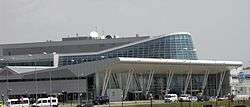 | |||||||||||
| Summary | |||||||||||
| Airport type | Public | ||||||||||
| Operator | Sofia Airport EAD | ||||||||||
| Serves | Sofia, Bulgaria | ||||||||||
| Location | Vrazhdebna | ||||||||||
| Hub for | |||||||||||
| Elevation AMSL | 1,742 ft / 531 m | ||||||||||
| Coordinates | 42°41′42″N 023°24′30″E / 42.69500°N 23.40833°ECoordinates: 42°41′42″N 023°24′30″E / 42.69500°N 23.40833°E | ||||||||||
| Website | sofia-airport.bg | ||||||||||
| Map | |||||||||||
 LBSF Location in Bulgaria | |||||||||||
| Runways | |||||||||||
| |||||||||||
| Statistics (2017) | |||||||||||
| |||||||||||
Sofia Airport (IATA: SOF, ICAO: LBSF) (Bulgarian: Летище София, Letishte Sofiya) is the main international airport of Bulgaria located 10 km (6.2 mi) east[1] from the centre of the capital city Sofia. In 2017 the airport surpassed 6 million passengers for the first time and handled a total of 6,490,096 passengers, a 30.3% increase compared to 4,980,387 passengers handled in 2016.[2] The airport serves as the home base for BH Air, Bulgaria Air, and Bulgarian Air Charter and as a base for both Ryanair and Wizz Air. The Vrazhdebna Air Base of the Bulgarian Air Force is also located at the airport.
History
Early years
The airport was initially built in the late 1930s on a site 6.3 km (3.9 mi) (7.5 km (4.7 mi) by road then; later 9 km (5.6 mi) by road and today 10.2 km (6.3 mi) and up to 11.4 km (7.1 mi)) distant from the geographical centre of Sofia as a replacement of that city's small civil airport at Bozhurishte. The airport was used as hub by domestic airline Bunavad which connected Sofia to Burgas, Plovdiv, Ruse and Varna. In 1938, Yugoslav airline Aeroput begin regular direct flights linking Sofia to Belgrade three times a week using Lockheed Model 10 Electra planes.[3] The airport served Sofia which then had under 250,000 inhabitants and continues to serve the city nowadays, which had about 1.2 million by 2011.
During the Second World War, the facilities were used by the military. Mail, perishable freight and passenger operations began in 1947 from buildings on the north side of the airport. The passenger terminal (now Terminal 1) on the south side was completed during the Second World War in the manner of a then-modern European railway terminus to designs by the architect Ivan Marangozov. It opened after several years of delay in 1947. The structure comprised a government wing to the west, an international handling area in the middle, and a domestic handling area to the east. At that time, it was planned that the airport would eventually have two intersecting runways at a 30-degree angle to each other.
The terminal had substantially reached its capacity of some 600,000 passengers a year by the later 1960s and was subjected to a number of refurbishments and extensions beginning in the spring of 1968. In 1975, a new international arrivals handling extension was opened to the west of the building, the domestic area to the east was enlarged, the government handling area was removed to a dedicated terminal some distance to the west, a VIP handling area opened in the old terminal, apron area was extended to the east and new taxiways opened. A bonded warehouse opened to the east of the terminal square in 1969 and several new hangars followed to the east of the first maintenance base in the 1970s. A new checked baggage handling system opened to the north of the building in the early 1980s, cosmetic and traffic reorganising refurbishments were carried out in 1990, with a substantial landside extension following in 2000.[4]
By the late 1970s, the terminal was handling in the region of three million passengers a year, a million of them on domestic routes. Passenger numbers fell off sharply after the 1979 CMEA ("Comecon") oil price shock and recovered to just over a million a year by the late 1980s. In the early and mid-1990s, domestic traffic practically ceased, while foreign traffic reduced significantly. The latter began growing apace in the late 1990s and early 2000s to reach its current levels. The terminal was last refurbished partially in 1990. In 2000, it underwent a wholesale update in which the international arrivals area was moved to the east wing where domestic handling had been, the former international arrivals area to the west was closed, and the layout of the central international departures area was changed in line with world developments. Despite the work to the old terminal, the airport was becoming overwhelmed with passenger traffic.[4]
Options for different airport developments began to be examined in the mid-1960s. One option was to relocate the facility to a new site, with some locations up to 70 km (43 mi) from Sofia. Another option involved extending the airport's area radically to the north-east and gradually removing the focus of the airport there. A third option was to develop substantially the same site. By the later 1980s, the authorities had settled on the last option.
Development since the 1990s
Project design, involving a new terminal to the east of the old facility, a new runway to the north of (and parallel to) the existing runway, and taxiways, was completed by the mid-1990s. A finance package involving very significant European and Kuwaiti investment was initially agreed in 1998 and was in place by 2000. Work began in 2001. The new runway and some taxiways were completed in mid-2006. Terminal 2 was formally inaugurated on 27 December 2006.[4]
Design and construction of a new control tower was discussed in 2006 but this project appeared to be in abeyance by 2008. Over the years, Sofia Airport has been criticised for its lack of world class air freight facilities and for some access problems. Passengers to and from the Bulgarian interior have to access or egress the airport through crowded rail and coach facilities in central Sofia. A rail link has been discussed on several occasions since the 1960s. The next best thing, perhaps, was the extension of Sofia Metro Line 1 some 5 km from Blvd Tsarigradsko shose. This was opened on 2 April 2015 under the name Sofia Airport Metro Station.[5] The airport metro station is adjacent to Terminal 2. Connection with terminal 1 is by free shuttle bus.
The airport is occasionally criticised as a source of environmental noise and pollution and strict noise abatement procedures have been enforced for departing traffic since the mid-1970s, while arriving traffic is generally routed to approach the field from the east, clear of Sofia.[4]
A significant and recurring operational criticism of Sofia Airport has concerned its historical lack of all-weather operations capability. Though the new runway was designed for ICAO Category 3 operations, in 2007 it emerged that radio interference from security fencing, and most significantly from a large newly built lorry park, prevented certification (and hence use) of the associated radio navigational aids. During the winter months, the airport, located on a high alluvial plain surrounded by mountains, suffers from very significant and frequent fog precipitation. In such circumstances, flights are redirected to diversion airports in Bulgaria or neighbouring countries, lengthening journeys by many hours.[4]
On 3 June 2016, the Bulgarian government launched a tender for the operation of Sofia Airport.[6] Expected to bring in 1.2 billion lev (600 million euro) to the state over 35 years, the tender has reportedly attracted interest from the operators of airports in Munich, Frankfurt, Zurich, Lyon, Dublin and London-Heathrow and as well other operators.[7]
Vrazhdebna Air Base
On the north side of the airport is located 16th Transport Air Base of the Bulgarian Air Force, operating with: 3 Alenia C-27J Spartan, 1 Antonov An-2, 1 Antonov An-24, 2 Antonov An-26, 1 Antonov An-30, 2 Let L-410 Turbolet and 1 Pilatus PC-12.
Airport reconstruction
Overview
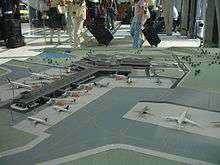
According to the plan a new Sofia airport terminal was built to the east of the old terminal and a second runway was constructed alongside the existing one. The old runway has been turned into a taxiway parallel to the newly constructed runway. Both cross the Iskar river. The new runway was opened in August 2006, while the new terminal opened in December 2006.[4]
Total cost of the project was planned at 200 million euros. Finance was secured in 1997–98 from the European Investment Bank (60 million euro), Kuwait Fund for Arab Economic Development (12.3 million Kuwaiti dinars, approximately 41.5 million euro), and the European Union PHARE Programme (7.6 million euro). In August 2000, an ISPA grant of 50 million euro was allocated and in December the financing memorandum was signed.[4]
The construction works were in two lots: the new terminal with its surrounding infrastructure and the new runway. The first lot was allocated to the German branch of Austrian company Strabag,[8] while the second was won by a consortium of Kuwaiti company Mohamed Abdulmohsin al-Kharafi & Sons and UAE-based Admak General Contracting Company.[9]
Delays to terminal construction
The initial completion deadline for the new terminal was 15 December 2004 to a total budget of 112.2 million euro. Immediately after work started, Strabag contested the geological surveys by Dutch consultants NACO B.V. and demanded additional funding for unexpected additional works. The delay was ten months, and construction resumed after the Bulgarian government agreed to augment the project's value by 4.8 million euro and extend the deadline to 31 August 2005.[10]
In 2004 Strabag demanded an additional 6 million euro due to rising steel prices.[11] The Ministry of Transportation rejected the claim, backed by a report from NACO. In May 2005 the contractor threatened to take the case to international arbitration.[12] In August 2005, it became clear that Strabag would not be able to meet the changed deadline, slippage being put at six to eight weeks.[13] In November 2005 Strabag asked for eight months' further extension.[14]
Runway system
On 31 August 2006, Sofia Airport put its new runway system into operation, replacing the old and out-of-date facilities. The new runway is offset at 210 m (690 ft) to the north of the old runway, with the eastern end of its 3,600 m (11,811 ft) long strip crossing over the Iskar river bed on a specially constructed bridge. New rapid and connecting taxiways are built additionally to open way for 20 aircraft movements per hour at a high level of safety. The navigational aids installed on the new runway enable landing operations under low visibility conditions at category IIIB of the ICAO standards.[15]
Two de-icing platforms are constructed to allow centralised de-icing procedures in winter. They are one element in the overall strategy of Sofia Airport for environmental protection and reduction of the harmful effects resulting from the airport operations. At the moment there is another de-icing platform under construction. [16]
Lufthansa Technik-Sofia
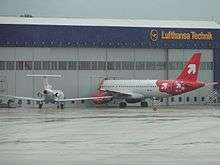
Lufthansa Technik Sofia was founded in late 2007 as a joint venture between Lufthansa Technik (75.1%) and the Bulgarian Aviation Group (24.9%).[17] With the foundation of Lufthansa Technik Sofia, the Lufthansa Technik Group has created a fifth platform for the overhaul and maintenance of narrowbody aircraft in Europe. The Bulgarian facility serves customers in Europe, the Middle East and North Africa. The facility has undergone a major reconstruction and an upgrade and now can handle the heaviest stage of aircraft maintenance checks, D-Check, that is now being carried out in Bulgaria. The company have started with more than 350 staff trained in Bulgaria and at Lufthansa Technik facilities in Shannon Base Maintenance operations in the fourth quarter of 2008 with one Airbus A321 from Lufthansa as the first customer.[18] At the moment the facility in Sofia has more than 1100 employees and plans by the 2018 to hire another 200 employees to reach a total of 1300 employees. The company have completed the building of a new facility in October 2017 which will be used for the maintenance of wide-bodied aircraft and is able to handle Airbus A380.[19] With the completion of the new hangar now Lufthansa Technik Sofia has 8 production lines which is turning the Bulgarian unit into the biggest unit of Lufthansa Technik.
Rose Air Technik
On 04 July 2018 Rose Air in cooperation with Wizz Air have opened new maintenance base at Sofia Airport.[20] It is located at the northern part of the airport. The hangar lays on 5000 square meters and has 3 production lines with overall capacity of 300 planes per year and it can handle C-Check. The base have started with more than 100 staff. This will be the first maintenance base for Wizz Air in the Balkans and the fourth in Europe.[21]
New control tower
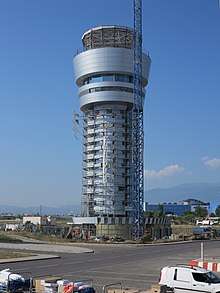
The new control tower was inaugurated officially on 5 December 2012 by the PM Boyko Borisov and the minister of transport Ivaylo Moskovski.[22]
The tower was built by Glavbolgarstroy AD. The contract for building the tower was signed on 19 August 2011 in the presence of Ivaylo Moskovski, minister of transport, information technology and communications, the BULATSA director general Diyan Dinev, Glavbolgarstroy AD chief executive director Pavel Kalistratov and Glavbolgarstroy AD executive director and management board member Nina Stoyanova signed the design execution and construction contract between BULATSA and Glavbolgarstroy AD for the new control tower at Sofia Airport (Sofia tower).[23] Glavbolgartroy AD were selected as contractor, as they were awarded the highest technical rating during the public procurement procedure having proposed the shortest construction timeframe. This project is being financed entirely by BULATSA.
The construction of the new Sofia tower is related to the reconstruction and development of Sofia Airport and is the natural extension of the development of the airport complex. The new control tower will allow BULATSA to ensure enhanced quality and efficiency of air navigation services (ANS) in the terminal area.
The new Sofia tower is situated to the west of Terminal 2 and is complementing the terminal building in architectural terms. The total built-up area of the tower is 2,400 m2 (26,000 sq ft) and its height is 50 m (160 ft). It also has the potential to serve the incoming and departing flights from one more runway, which paves the way for the future development and expansion of the airport.[24]
Project history
The project for the construction of a new airport control tower at Sofia Airport commenced on 16 June 2006 with a decision of the BULATSA Management Board. Below is an outline of the main developments:
- In 2007 a council of experts was tasked to develop the project's technical assignment and prepare the documentation for a competition programme in order to acquire a conceptual design for the construction of a new airport control tower and its adjacent infrastructure. A competition programme for a conceptual design was drafted and coordinated with the CAA, the Bulgarian Chamber of Architects, the Bulgarian Architects' Union and the Chamber of Engineers Involved in Investment Design.
- An open public procedure for a conceptual design for the construction of the new tower and its adjacent infrastructure was held in 2008. During the same year a contract was signed with Mix Consult OOD who would act as a consultant in the meaning of Article 166 of the Law of the Administrative Territorial Structure of the Republic of Bulgaria during the process of design and construction of the tower.
- In 2009, a contract was concluded with Architectonika Studio OOD for the elaboration of a technical investment project as well as a contract with AT Engineering 2000 OOD, Sofia, for the construction of a fence and the separation of the construction site from the security area of Sofia Airport.
- On 6 January 2010, the Ministry of Regional Development and Public Works of the Republic of Bulgaria issued building permit No. 3/06.01.2010 for the construction of the new airport control tower and its adjacent infrastructure.
- The selection procedure for a contractor of the design execution and construction of the new tower at Sofia Airport was completed on 19 July 2011.[25]
The new control tower is an extremely important facility for both ATC and the airport because it is related to the safety and security of flights, explained by the transport department.The idea of creating her since 2006, but still not realized. The location of the new airport control tower is west of the building of Terminal 2 at Sofia airport, from an architectural point of view the two buildings complement each other. The total building area is over 2,400 m2 (26,000 sq ft) and the height of the building will be 50 m (160 ft).
Service life of the new airport control tower will be more than 40 years and is designed to serve the airport with a possible extension.
The manager will have full visibility over the airport, to guide aircraft landing and taking off. Glass tower will have a maximum UV protection. Hall does it is completely soundproofed. A record will be the deadline for building the new facility – just 10 months. The need to build a new control tower is connected with the reconstruction and expansion of the airport and is a natural development of the airport complex, reported from the transport department.[26]
Contract for detailed design and construction of a new control tower of the airport and forming an ATM Glavbolgarstroy. The tower will be 50 meters high and will be built near Terminal 2, as both architectural buildings will be complementary.
The new tower was officially opened on 5 December 2012.[27]
Terminals

Terminal 1
This terminal was built in the first half of the 20th century, and opened on 16 September 1937. It has been extended and improved many times, including a major renovation in 2000. Terminal 1 offers easy access, simple procedures and efficient services up to the modern airport standard. Terminal 1 currently serves low-cost and charter carriers.
Terminal 2
Terminal 2 was officially opened on 27 December 2006 with the symbolic arrival of Bulgaria Air flight FB 408 from Brussels. It was one of the biggest projects in Bulgaria to receive funds from the EU ISPA programme. The price includes the new terminal, new aircraft parking aprons, upgrading the existing aircraft parking aprons and the construction of connecting taxiways. The terminal has seven air-bridges (gates A1, B5–9 and C1), 38 check-in desks and covers an area of 50,000 m2 (540,000 sq ft) and has a car park for 820 vehicles. It is located to the east of Terminal 1 and is significantly bigger than the old one which continues to serve low-cost and charter airlines. From 16 January 2017 on Terminal 2 currently serves only one low-cost airline - Ryanair.[28]
The passenger terminal building is designed with a capacity of 2,000 peak hour passengers or up to 2.6 million passengers a year, plus 26,000 tonnes of luggage. For the first time in Bulgaria, a terminal has airbridge-equipped gates instead of relying on airside buses.
The Sofia Airport Centre, a premiere corporate office, hospitality and logistics centre in Bulgaria is being constructed in the vicinity. At the eastern end of the Terminal, an end station for Line 1 of the Sofia Metro has been built under the name Sofia Airport Metro Station. It was brought into service on 2 April 2015. The journey between airport and central Sofia takes about 20 minutes with service provided 05.30-24.00 hrs.[5]
The infrastructure surrounding the building was expected to be completed in 2007. It includes a new dual carriageway road connecting the terminal to the existing airport road, and landscaping including an artificial lake and a fountain. Terminal 2 is designed with special attention to disabled passengers. Their access to the different terminal levels and the multi-storey car park is facilitated via lifts and escalators.[29]
Other facilities
The VIP terminal is located in the western wing of Terminal 1 and has an entrance of its own, providing an access to four separate rooms – one main room and two separated rooms with about 20 seats each.[30]
The Government terminal is located in the western side of Sofia Airport. The terminal is often used by foreign heads of state visiting Bulgaria. The terminal is operated by the 28th Air Detachment which operates government aircraft and operations involving the President, Prime Minister and other high-ranking government officials.
Airlines and destinations
Passenger
Cargo
| Airlines | Destinations |
|---|---|
| ASL Airlines Belgium | Bucharest, Liège |
| ASL Airlines Switzerland | Belgrade, Prague |
| DHL Aviation | Bratislava, Leipzig/Halle |
| UPS Airlines | Cologne/Bonn, Timişoara |
Statistics
Traffic
| Year | Passengers | Change | Cargo (tonnes) | Change | Aircraft movements | Change |
|---|---|---|---|---|---|---|
| 1998 | 1,250,700 | 10,180 | 24,726 | |||
| 1999 | 1,236,610 | 12,378 | 25,178 | |||
| 2000 | 1,127,866 | 11,036 | 24,785 | |||
| 2001 | 1,107,682 | 10,381 | 21,860 | |||
| 2002 | 1,214,198 | 12,482 | 24,211 | |||
| 2003 | 1,356,469 | 13,461 | 25,517 | |||
| 2004 | 1,614,304 | 14,472 | 28,700 | |||
| 2005 | 1,874,000 | 14,725 | 32,188 | |||
| 2006 | 2,209,350 | 15,241 | 38,119 | |||
| 2007 | 2,745,880 | 17,392 | 43,005 | |||
| 2008 | 3,230,696 | 18,294 | 48,626 | |||
| 2009 | 3,134,657 | 15,093 | 45,698 | |||
| 2010 | 3,296,936 | 15,322 | 47,061 | |||
| 2011 | 3,474,933 | 15,887 | 47,153 | |||
| 2012 | 3,467,455 | 16,249 | 40,806 | |||
| 2013 | 3,504,326 | 17,039 | 40,526 | |||
| 2014 | 3,815,158 | 17,741 | 42,120 | |||
| 2015 | 4,088,943 | 18,727 | 44,416 | |||
| 2016 | 4,979,760 | 20,886 | 51,829 | |||
| 2017 | 6,490,096[49] | 20,818[50] | 57,673[51] | |||
| 2018 (01.01 - 31.05) | 2,755,037[52] | 9,121[53] | 24,307[54] |
Busiest routes
Busiest destinations
| Rank | City | Airlines | Passengers | Rank Change |
|---|---|---|---|---|
| 1. | 422,821 | |||
| 2. | 134,306 | |||
| 3. | 129,039 | |||
| 4. | 122,138 | |||
| 5. | 118,431 | |||
| 6. | 107,660 | |||
| 7. | 100,900 | |||
| 8. | 98,303 | |||
| 9. | 98,100 | |||
| 10. | 88,675 | |||
Busiest airlines
| Rank | Airline | Passengers carried | % |
|---|---|---|---|
| 1. | |||
| 2. | |||
| 3. | |||
| 4. | |||
| 5. | |||
| 6. | |||
| 7. | |||
| 8. | |||
| 9. | |||
| 10. | |||
Transport links
Metro

Sofia Airport Metro Station of Line 1 is situated next to Terminal 2 of the airport and provides a fast connection to the city centre.[61]
A free shuttle bus is available from Terminal 1 to Terminal 2 and the Metro Station between 07:00 and 19:00 h.
Sofia Metro also provides a fast connection between the airport and Business Park Sofia.[62]
Bus
Three bus routes (84, 184 and 384) serve the airport.
- Line 84 goes to the Sofia University from Terminal 2 via Terminal 1 and connects the airport with the city centre.
- Line 184 goes to the Sofia University from Terminal 1 via Terminal 2.
- Line 384 connects the airport with the Tsarigradsko shose Metro Station.[63]
Car
Brussels Boulevard is the main thoroughfare and the easiest way to reach Sofia Airport. There is a new, faster connection built from Terminal 2 to Brussels Boulevard.[64]
Via Brussels Boulevard and Tsarigradsko shose, Sofia Airport is connected to the city centre and eastwards to Trakia motorway (A1) ![]()
From the northern city areas, Sofia Airport is conveniently accessible via the East Tangent street. Its junction with Botevgradsko Shose opens an exit into Hemus motorway (A2) ![]()
To the south parts of Sofia and southwest Bulgaria the easy way to connect is via Brussels Boulevard] and Boulevard Aleksandar Malinov to Sofia ring road ![]()
![]()
Train
A specially built train station was inaugurated in April 2015 which connects the airport with the national railway system of Bulgaria. Situated at about 2.5 km (2 mi) from terminal 2, the train station is interconnected with Iskarsko shose Metro Station which is the second metro station after Sofia Airport Metro Station.[66]
Incidents and accidents
- On 22 December 1971, a Balkan Airlines Il-18 crashed en route to Algeria. 28 people on board died.
- On 22 November 1975, a Balkan Bulgarian airlines An-24 crashed short of the runway after take-off in icy conditions. Of the 48 people on board, three were killed.
- On 10 January 1984, a Balkan Bulgarian Airlines Tupolev Tu-134 crashed on approach in bad weather. All 50 people on board died.
- On 2 August 1988, a Balkan Airlines Yak-40 crashed in the Iskar river. There were 28 fatalities among the 37 passengers on board.
- On 17 May 2012, an OLT Express Airbus A320 flight YAP-7107 from Warsaw (Poland) to Hurghada (Egypt) with 152 people on board performed an emergency landing. During the descent, the crew reported a fire in the cabin and loss of pressure. The aircraft landed safely and was evacuated via slides. No injuries occurred. The airport was closed to traffic for one hour.
Gallery
- In front of Terminal 2
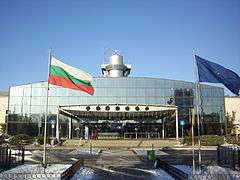 In front of Terminal 1
In front of Terminal 1- Outside Terminal 2
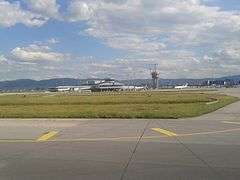 Sofia Airport, Terminal 2
Sofia Airport, Terminal 2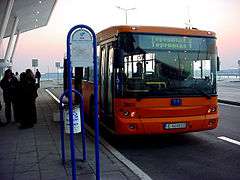 Bus Number 84 at Sofia Airport
Bus Number 84 at Sofia Airport- Terminal 2 interior
- Terminal 2 interior
- Check-in area of Terminal 2
- Outside view of Terminal 2
- Outside view of Terminal 2
See also
References
- 1 2 "EAD Basic - Error Page". Retrieved 3 June 2015.
- ↑ https://sofia-airport.bg/sites/default/files/bg-passengers_2016-2017_12.pdf
- ↑ Drustvo za Vazdusni Saobracaj A D – Aeroput (1927–1948) at europeanairlines.no
- 1 2 3 4 5 6 7 "First-class upgrade to Bulgaria's international gateway". Retrieved 3 June 2015.
- 1 2 DVV Media UK. "Sofia airport metro link opens". Railway Gazette. Retrieved 3 June 2015.
- ↑ "Bulgaria opens 35-year concession tender for Sofia Airport". SEE News. 3 June 2016.
- ↑ "Bulgaria launches tender to operate Sofia airport". Daily Mail. Retrieved 18 May 2016.
- ↑ "- - The Sofia Echo". Retrieved 3 June 2015.
- ↑ http://www.dnevnik.bg/biznes/companii/2002/07/09/119722_arabski_konsorcium_shte_stroi_novata_pista_na_letishte/
- ↑ "- - The Sofia Echo". Retrieved 3 June 2015.
- ↑ "Стандарт - Новини, които си струва да споделим". Стандарт - Новини, които си струва да споделим. Archived from the original on 22 October 2007. Retrieved 3 June 2015.
- ↑ "Economedia". Retrieved 3 June 2015.
- ↑ Ministry of transportation Minister Mutafchiev met Strabag representatives Archived 4 October 2008 at the Wayback Machine. (in Bulgarian)
- ↑ "Economedia". Retrieved 3 June 2015.
- ↑ https://www.sofia-airport.bg/en/sofia-airport/company/and-today
- ↑ https://sofiaairportlbsf.files.wordpress.com/2013/11/vfr.png
- ↑ http://www.lufthansa-technik.com/lufthansa-technik-sofia
- ↑ "Maintenance, repair and overhaul (MRO) of aircraft - Lufthansa Technik AG". Archived from the original on 28 February 2011. Retrieved 3 June 2015.
- ↑ https://money.bg/investments/lufthansa-prevrashta-sofiya-v-nay-golyamata-si-baza-za-remont-na-samoleti-v-evropa.html
- ↑ https://technews.bg/article-109330.html
- ↑ https://www.capital.bg/biznes/kompanii/2018/07/04/3211019_wizz_air_shte_poddurja_samoletite_si_v_nov_hangar_na/
- ↑ "Sofia Airport New ATC Tower Able to Serve 2nd Runway". Retrieved 3 June 2015.
- ↑ Нова кула и бърза писта на летището
- ↑ http://www.novinite.com/articles/145816/Sofia+Airport+New+ATC+Tower+Able+to+Serve+2nd+Runway
- ↑ BULATSA launched the construction of a new Airport Control Tower at Sofia Airport
- ↑ 50-metres tower will be stands at Sofia Airport (in Bulgarian)
- ↑ "Sofia Airport New ATC Tower Able to Serve 2nd Runway". Retrieved 3 June 2015.
- ↑
- ↑ Sofia Airport Archived 18 January 2009 at the Wayback Machine.
- ↑ "Archived copy". Archived from the original on 15 September 2012. Retrieved 27 September 2012.
- 1 2 3 4 5 6 7 8 9 10 11 12 http://www.sofia-airport.bg/en/passengers/flight-information/airlines
- ↑
- ↑ https://www.air.bg/en/destinations/
- ↑ https://www.routesonline.com/news/38/airlineroute/278296/bulgaria-air-schedules-additional-charter-routes-in-sep-2018/?highlight=sofia
- ↑ https://www.routesonline.com/news/38/airlineroute/278296/bulgaria-air-schedules-additional-charter-routes-in-sep-2018/?highlight=sofia
- 1 2 https://www.routesonline.com/news/38/airlineroute/279630/easyjet-schedules-new-routes-from-the-uk-in-w18/
- ↑
- ↑ https://www.flybe.com/flights-from/sofia/
- ↑ https://flights.ryanair.com/en-gb/flights-from-bulgaria-to-bristol
- ↑ https://corporate.ryanair.com/news/ryanair-announces-11-new-w18-routes-from-edinburgh/
- ↑ https://corporate.ryanair.com/news/ryanair-announces-11-new-w18-routes-from-edinburgh/
- ↑ https://corporate.ryanair.com/news/ryanair-launches-new-sofia-route-to-aqaba/?market=bg
- ↑ http://www.crystalski.co.uk
- ↑ https://www.routesonline.com/news/38/airlineroute/280613/ukraine-international-s19-european-network-expansion/
- ↑ https://www.routesonline.com/news/38/airlineroute/280613/ukraine-international-s19-european-network-expansion/
- ↑ https://wizzair.com/en-gb/flights/timetable/sofia/athens--#/0/0/1/0/0/2018-10/2018-10
- ↑ https://wizzair.com/en-gb/flights/timetable/sofia/varna-black-sea#/0/1/1/0/0/2018-10/2018-10
- ↑ https://wizzair.com/en-gb/information-and-services/about-us/news/2018/08/09/wizz-air-continues-its-expansion-in-eilat-israel#/
- ↑ https://www.sofia-airport.bg/sites/default/files/en-passengers_2016-2017_13.pdf
- ↑ https://www.sofia-airport.bg/sites/default/files/en-cargo_and_mail_2016-_2017_9.pdf
- ↑ https://www.sofia-airport.bg/sites/default/files/en-aircraft_movements_2016-2017_11.pdf
- ↑ https://www.sofia-airport.bg/sites/default/files/en-passengers_2017-2018_4.pdf
- ↑ https://www.sofia-airport.bg/sites/default/files/en-cargo_and_mail_2017-_2018_3.pdf
- ↑ https://www.sofia-airport.bg/sites/default/files/en-aircraft_movements_2017-2018_4.pdf
- ↑ https://www.flightradar24.com/data/airports/sof/routes
- ↑ http://www.sofia-airport.bg/en/passengers/flight-information/search-flight
- ↑ https://www.sofia-airport.bg/sites/default/files/top_destinations_2016_eng.pdf
- ↑ https://www.sofia-airport.bg/sites/default/files/top_destinations_2017_eng.pdf
- ↑ https://www.sofia-airport.bg/sites/default/files/top_airlines_2016_en.pdf
- ↑ https://www.sofia-airport.bg/sites/default/files/top_airlines_2017_en.pdf
- ↑ "Sofia Airport Metro". Retrieved 3 June 2015.
- ↑ "Mayor of Bulgaria capital to attend metro extension inauguration". FOCUS Information Agency. Retrieved 3 June 2015.
- ↑ "Schedules - Urban transport". Retrieved 3 June 2015.
- ↑ http://infrastructure.bg/news/2017/03/23/2934860_put_s_estakada_do_terminal_2_na_letishte_sofiia/
- ↑ "От и до летището - Летище София". Archived from the original on 6 February 2015. Retrieved 3 June 2015.
- ↑ "Все така без табели за метрото на Летище София". bTV Новините. Retrieved 3 June 2015.
External links
![]()
